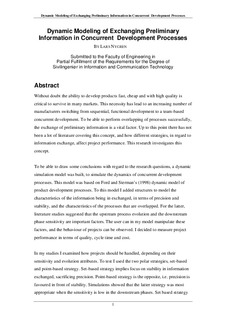| dc.description.abstract | Without doubt the ability to develop products fast, cheap and with high quality is critical to survive in many markets. This necessity has lead to an increasing number of manufacturers switching from sequential, functional development to a team-based concurrent development. To be able to perform overlapping of processes successfully, the exchange of preliminary information is a vital factor. Up to this point there has not been a lot of literature covering this concept, and how different strategies, in regard to information exchange, affect project performance. This research investigates this concept.
To be able to draw some conclusions with regard to the research questions, a dynamic simulation model was built, to simulate the dynamics of concurrent development processes. This model was based on Ford and Sterman’s (1998) dynamic model of product development processes. To this model I added structures to model the characteristics of the information being in exchanged, in terms of precision and stability, and the characteristics of the processes that are overlapped. For the latter, literature studies suggested that the upstream process evolution and the downstream phase sensitivity are important factors. The user can in my model manipulate these factors, and the behaviour of projects can be observed. I decided to measure project performance in terms of quality, cycle time and cost.
In my studies I examined how projects should be handled, depending on their sensitivity and evolution attributes. To test I used the two polar strategies, set-based and point-based strategy. Set-based strategy implies focus on stability in information exchanged, sacrificing precision. Point-based strategy is the opposite, i.e. precision is favoured in front of stability. Simulations showed that the latter strategy was most appropriate when the sensitivity is low in the downstream phases. Set based strategy was most effective in projects where the sensitivity was high. Simulations finally showed that the concept of finalising early, i.e. committing to a design before all tasks are finished in the upstream phase should be facilitated when the upstream phase is fast evolving. That way cycle time could be reduced without sacrificing quality notably. | en |
